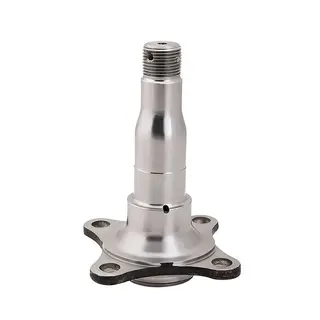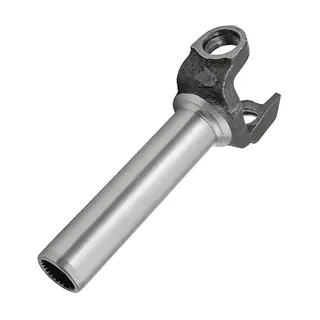In the field of metal processing, the forging heating process is a crucial step. However, if this process is not performed correctly, it can easily lead to various defects, seriously affecting the performance and quality of forgings. This article will provide an in-depth analysis of common defect types during the forging heating process, their causes, and preventive measures. The goal is to provide practical guidance for professionals in the field, ensuring the production of high-quality forged products.
In metal processing, the forging heating process is one of the key steps to ensure product quality. However, improper handling of this process can lead to a range of defects, severely impacting the performance and quality of the forgings. Therefore, a thorough understanding of defect types caused by improper heating and their root causes is of vital importance for optimizing production processes and improving product quality.
Oxidation: During heating, the metal surface reacts chemically with the oxidizing gases in the furnace atmosphere, forming an oxide layer composed of Fe₃O₄, Fe₂O₃, and FeO. This oxidation phenomenon not only degrades the surface quality of the metal but also increases material loss. For example, each heating cycle of a forging can lead to 1.5%–3% of the metal being lost due to oxidation. Moreover, the formation of oxide scale may become entrapped on the workpiece surface during subsequent rolling or forging, affecting the dimensional accuracy and surface quality of the forging and even reducing the service life of the die.
Decarburization: Decarburization refers to the oxidation of carbon in the surface layer of steel at high temperatures, resulting in a significantly lower carbon content on the surface compared to the interior. This phenomenon is closely related to the steel's composition, the furnace atmosphere, temperature, and holding time. High-carbon steels and steels with high silicon content are more prone to decarburization. Decarburization decreases the part's strength and fatigue resistance while weakening wear resistance. For instance, parts that have undergone decarburization are more likely to experience wear and fracture during service.
Carburization: Forgings heated in oil-fired furnaces often experience carburization on their surfaces or partial surfaces. When a billet is close to the oil burner nozzle or in regions where two nozzles intersect, incomplete combustion creates a reducing carburizing atmosphere on the surface of the billet, leading to surface carburization. Carburization adversely affects the machining performance of the forging, making it prone to work hardening during cutting and complicating subsequent machining processes.
Sulfur and Copper Penetration: Phenomena such as sulfur or copper penetration are also influenced by the heating medium. For instance, residual copper oxide in the furnace can reduce to free copper at high temperatures. The molten copper atoms diffuse along the austenite grain boundaries, weakening the intergranular bonding, which can lead to “hot shortness” or copper brittleness. Copper brittleness manifests as cracking on the forging surface and severely impacts its mechanical performance.
Overheating: Overheating occurs when the billet is heated to excessively high temperatures or remains too long within the prescribed forging and heat treatment temperature range, causing coarse grains. Different steel types exhibit distinct microstructural features after overheating. For example, carbon steels typically develop ferritic structures upon overheating, whereas martensitic steels may form intragranular textures. Overheated structures reduce mechanical properties, especially impact toughness. However, in most cases, structural steels can partially restore their microstructure and properties through normal heat treatment.
Burning: Burning is a more severe condition than overheating. When a billet is heated at excessively high temperatures or resides too long in high-temperature zones, oxygen and other oxidizing gases in the furnace penetrate the gaps between metal grains and react with iron, sulfur, carbon, and other elements to form low-melting eutectic oxides. This disrupts the grain boundary bonding, drastically reducing the material's plasticity. Burned metal is highly susceptible to cracking during forging and cannot be salvaged through conventional heat treatment methods.
Incomplete Heating: Incomplete heating refers to the situation where the interior of the billet does not reach sufficient temperature, resulting in uneven internal and external temperatures. This may cause cracks during forging, compromising the overall performance of the forging. For example, when heating large cross-sectional billets or high-alloy steels with poor thermal conductivity, if the heating rate is too fast during the low-temperature stage, the temperature difference between the surface and core may produce thermal cracks.
When the temperature distribution inside the billet is uneven, internal stresses such as thermal stress and microstructural stress develop. If these stresses are excessive, the billet may crack. For instance, large steel ingots or high-alloy billets with poor thermal conductivity may develop radially oriented thermal cracks from the center outward if heated too quickly during the low-temperature stage, causing the entire cross-section to fracture.
After exploring the types of defects caused by improper heating processes, the next question arises: How do these defects originate? Understanding the root causes is crucial for preventing and resolving these problems.
Influence of Furnace Atmosphere: An oxidizing atmosphere is one of the primary causes of oxidation and decarburization. When the furnace atmosphere contains a large amount of oxidizing gases (such as O₂, CO₂, H₂O), the metal surface is more prone to oxidation. Additionally, these oxidizing gases react with carbon in the steel, leading to decarburization. For example, heating steel in an oxidizing atmosphere will produce both oxidation and decarburization simultaneously.
Heating Temperature and Time: Heating temperature and time significantly affect oxidation and decarburization. As the heating temperature increases, the rates of oxidation and decarburization accelerate. When the temperature reaches a critical point, decarburization may proceed faster than oxidation. Moreover, longer heating times deepen the decarburized layer. Therefore, controlling heating temperature and duration is key to minimizing oxidation and decarburization.
Steel Composition: The composition of steel also influences oxidation and decarburization. High-carbon steels and steels with high silicon content are more prone to decarburization. Alloying elements such as tungsten (W), aluminum (Al), silicon (Si), and cobalt (Co) increase the tendency for decarburization, while chromium (Cr) and manganese (Mn) inhibit it. Consequently, steel selection should consider processing requirements and heating conditions, ensuring the appropriate type and content of alloying elements.
Excessive Heating Temperature: The main cause of overheating and burning is excessive heating temperature. When the billet temperature exceeds its critical point, grains rapidly grow, leading to overheating. When the temperature approaches or reaches the melting point of the metal, burning occurs. Different steel types have different overheating and burning thresholds, so strict temperature control is essential during heating to avoid exceeding the prescribed range.
Excessive Holding Time: In addition to high heating temperature, prolonged residence of the billet in high-temperature zones also contributes to overheating and burning. Even if the temperature does not exceed critical limits, extended holding can lead to abnormal grain growth and microstructure defects. Thus, the residence time in the high-temperature zone should be carefully controlled to minimize these issues.
Influence of Alloying Elements: Alloying elements significantly affect steel's susceptibility to overheating and burning. Elements such as carbon (C), manganese (Mn), sulfur (S), and phosphorus (P) increase overheating tendencies, whereas nickel (Ni) and molybdenum (Mo) can make steel more prone to burning. When designing steel composition, the effects of alloying elements must be balanced to reduce susceptibility to overheating and burning.
Excessive Heating Rate: When heating large cross-sectional or poorly conductive billets, an excessively fast heating rate during the low-temperature stage may create large internal temperature gradients, inducing internal stresses. If the stress exceeds the billet's strength limit, thermal cracks form. Therefore, heating speed must be carefully controlled, particularly during the low-temperature stage, to ensure uniform temperature rise.
Improper Furnace Loading: How billets are positioned in the furnace affects temperature distribution. If billets are placed in local high-temperature zones, uneven heating results, causing temperature differences across the billet. Proper arrangement of billets in the furnace is necessary to achieve uniform temperature distribution.
Uneven Furnace Atmosphere: An uneven furnace atmosphere can also cause temperature gradients. Local oxidizing or reducing zones affect heating uniformity, creating inconsistent internal and external temperatures. Controlling the furnace atmosphere to ensure uniform distribution is crucial.
After analyzing the defect types and their causes, it is important to identify practical strategies to prevent these defects, ensuring that forging quality and performance meet expected standards.
Shortening Heating Time: Reducing heating time, particularly at high temperatures, minimizes oxidation and decarburization. Optimizing heating procedures and controlling temperature and speed ensures minimal time in the high-temperature zone, lowering the likelihood of defects.
Using Neutral or Protective Atmospheres: Heating in neutral or protective atmospheres is effective in reducing oxidation and decarburization. Controlled atmosphere furnaces can maintain a neutral or reducing atmosphere to protect the billet surface. Common protective gases include nitrogen (N₂), hydrogen (H₂), and argon (Ar).
Applying Protective Coatings: Coating billet surfaces with protective layers such as glassy coatings, glass-ceramic coatings, metallic coatings, or glass-metal coatings can isolate the surface from the furnace atmosphere, preventing oxidation and decarburization. These coatings provide thermal insulation and oxidation resistance at high temperatures.
Controlling Furnace Atmosphere Composition: Properly controlling the composition and pressure of the furnace atmosphere reduces oxidation and decarburization. Adjusting airflow to limit excess oxygen and preventing cold air ingress into the furnace further mitigates oxidation.
Strictly Controlling Heating Temperature: Temperature control is key to preventing overheating and burning. Heating temperatures should be set based on steel type and processing requirements, monitored to ensure they do not exceed prescribed limits. For example, carbon steel should be heated at 100–200℃ below its melting point to avoid burning.
Reducing High-Temperature Holding Time: Minimizing the time spent in high-temperature zones reduces the likelihood of grain growth and abnormal microstructures. Optimizing heating procedures ensures minimal high-temperature residence.
Proper Alloy Selection: Selecting suitable alloying elements reduces overheating and burning tendencies. Elements enhancing oxidation resistance, such as Cr and Mn, are preferred, while elements that increase susceptibility, such as Ni and Mo, should be limited.
Ensuring Adequate Forging Deformation: Sufficient deformation during forging breaks coarse grains formed during overheating and disrupts continuous precipitate networks along grain boundaries, improving or eliminating overheating effects.
3. Measures to Prevent Uneven Temperature Distribution
Controlling Heating Rate: The heating rate should be carefully controlled, especially for large or low-thermal-conductivity billets, to ensure uniform internal and external temperature rise.
Proper Furnace Loading: Billet placement should ensure even temperature distribution, avoiding local hot spots and allowing uniform spacing for heat flow.
Optimizing Furnace Atmosphere Distribution: Designing furnace structure and ventilation systems to achieve a uniformly distributed atmosphere helps reduce temperature gradients. Multi-point air supply and exhaust systems improve atmospheric uniformity and heating efficiency.
The forging heating process is a critical step in metal processing. Improper heating can lead to defects such as oxidation, decarburization, overheating, burning, and cracking, seriously compromising forging performance and quality. By thoroughly analyzing defect types, their causes, and preventive measures, effective strategies can be implemented to minimize or prevent defects. In practical production, heating processes should be optimized based on material characteristics and processing requirements. Temperature, time, and furnace atmosphere must be strictly controlled, while protective measures such as surface coatings and protective atmospheres should be applied to ensure high-quality forged products. Only through such measures can production efficiency and economic benefits be improved, meeting market demand for high-quality metal products.



